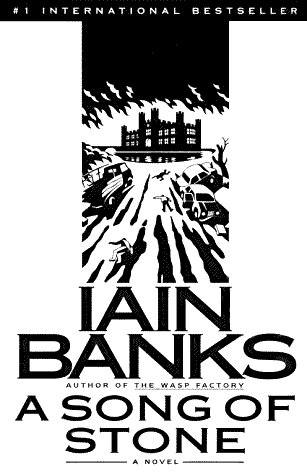 "A
Song of Stone" by Iain Banks
"A
Song of Stone" by Iain Banks "A
Song of Stone" by Iain Banks
"A
Song of Stone" by Iain Banks
The somewhat flowery, affected prose of this book is at first a little off-putting. The language is concatenated, dense, hugely descriptive and flows thickly, even sluggishly, through the pages. Less a story telling than a slow immersion into a surreal, meticulously observed, if tightly bounded, world. First impressions are deceptive, as the reader can easily suspect self-indulgence on the part of the author. The effect is so overwhelming that the reader at first fails to see the trademark Banks intricacy of plot and story that exists here, as in all his writing.
A lack of place-names lends a timeless, unreal quality to the world of Abel, Morgan and The Lieutenant.. The story is told, nominally at least, as a second person narrative, although to all intents and purposes, it is a first person's point of view, that of Abel. This device feels mildly gimmicky at first, but the reader soon adjusts. The first person approach allows for much self-analysis by the protagonist, who is quite an unsympathetic character, it must be said. For some readers, this could be another weakness in the story, a bar to enjoyment by a wider audience.
For all of the aforementioned reasons, "A Song of Stone" could be described, after a first reading, as an interesting stylistic experiment at best, or an unsatisfactory departure from the normal Banks standard of writing, at worst. It is worth reserving judgement, however, until after a second reading. Yes, I am to be an apologist for a book that has failed to capture the affectation of even staunch fans of Iain Menzies Banks' work.
The reader is, or ought to be, aware of undercurrents within the story - certain symmetries present themselves, but it is difficult to grasp many of them without knowing a crucial item of information. The story has, broadly speaking, four principle characters - Abel (the narrator), Morgan, The Lieutenant and, finally, The Castle. The surface interaction between each main character is of course pivotal, but there are further ironies to be enjoyed. I am indebted to Roger Gray, friend of the author, who passed on to me this important hint: each character represents an element - Water, Air, Fire and Earth. The interrelationship between each element, the characters and their surroundings, makes for an absorbing exercise for the reader, rewarding subsequent readings accordingly. . The level of detail in which the story is told means that the reader is repeatedly presented with minor, and amusing, ironies when this central premise is kept in mind.
My interpretation is that The Castle represents "Earth", for obvious reasons. Morgan is "Air", with her ethereal personality and the way she seems to float in and out of the focus of the story. The Lieutenant, a dangerous, destructive and unpredictable character, represents "Fire". Abel is "Water", but not simply because I, like many others, find him somewhat "wet".
The reader's perception of character interaction can thus become enriched. Abel and Morgan, Water and Air, combine to form a frothy, bubbly, yet insubstantial bond. Abel and The Lieutenant are Water and Fire - at first Fire is dampened down, kept in check, subsequently steam seems to result as she becomes openly ascendant. The Castle initially resists the Fire of The Lieutenant, but ultimately suffers the conflagration of "Loot's" forces. Morgan flits through of the Castle like a breeze or a ghost, sometimes appearing at the Castle windows at unpredictable moments. Morgan's relationship with The Lieutenant is the fanning of the flames that leads to the final crisis
The fate of each character is similarly linked. Earth finds its end in Fire, Water in a blast of Air (from the cannon captured by The Lieutenant), Fire is crushed by Earth in the form of a pair of millstones, and Air drowns in the Water of the Castle moat.
When the basic premise of the story is revealed, the existence of the Four Elements, it is possible to appreciate more fully what Banks has set out to do, and to a great extent, achieved. "A Song of Stone" will never be my favourite novel, but it is rewarding for those who wish to work at it.
Loznik
29 July 1999